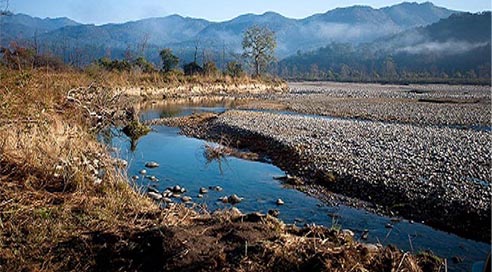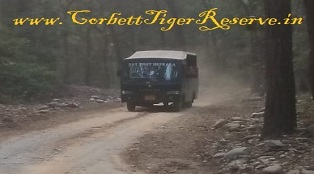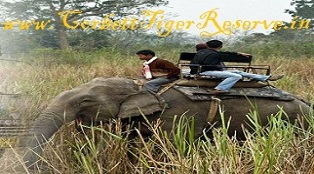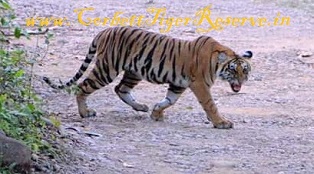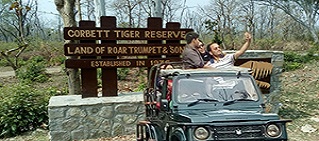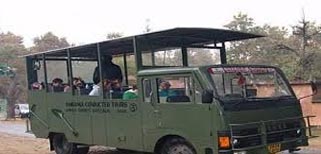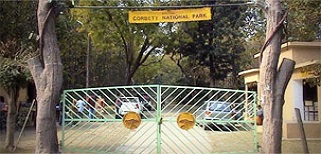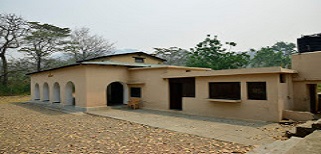CORBETT TIGER RESERVE

Corbett Tiger Reserve is an ideal home for many majestic animals like the Royal Bengal Tiger, Asiatic Elephant, Reptiles, Birds and many other wild animals. Corbett Tiger Reserve has captured the imagination of many with its diverse wildlife and breathtaking landscapes. The natural uniqueness of the area was recognized long ago as a result of which in 1936 Corbett attained the distinction of becoming the first National Park to be established in mainland Asia. The park was then named as the 'Hailey National Park' and was later renamed as 'Corbett National Park' after James Edward Corbett the noted hunter turned conservationist of the area. The area came under 'Project Tiger' in 1971 when Gov. of India launched this ambitious conservation project.
Today after addition of areas into the originally declared National Park, the total area of Tiger Reserve extends 1288.31 sq. kms spreading over three districts of Uttarakhand viz., Pauri, Nainital and Almora. Corbett National Park covers an area of 521 sq. km and together with the neighboring Sonanadi Wildlife Sanctuary and Reserve Forest areas, forms the Corbett Tiger Reserve. Geographically it is located between the Shiwalik Himalayas and the terai. The streams, rivers and ridges crisscrossing the terrain, present Corbett with a remarkable variety of landscapes. This vivid mosaic of habitats wet and dry, plain and mountainous, gentle and rugged, forests and grasslands supports numerous plant and animal species, representing Himalayan as well as plains ecosystem. The most famous of Corbett's wild residents are the Royal Bengal Tiger and the Asiatic Elephant. In addition to that with over 550 species of avifauna Corbett is one of the richest bird regions of the Country and has been declared as an 'Important Bird Area' (IBA) by Birdlife International.
Corbett tiger reserve is located in Ramnagar in Nainital district. The distinctive features of the park are
- It has sub Himalayan belts
- It is a best eco-tourism destination
- It has 488 different species of plants
- Rich fauna
- The climate is sub-tropical
- It has Sonanadi, Bijrani, Jhirna, Dhela, Durgadevi, Dhikala & Garjiya Tourism Zones.
The dense Jungles of the Corbett National Park were the private land of the local rulers as the princely state of Tehri Garhwal before the years 1815-20 of the British Rule. The jungles were uninhabited to make the area less unprotected to Rohilla attackers. The Maha Raja of Tehri authoritatively surrendered a division of his princely state to the East India Company in return for their support in ousting the Gurkhas from his state. Even if the actuality that the rights had passed into the British hands, the government compensated modest or no concern to the protection of the park.The single aim was to develop the natural resources and take out as much profits as possible from the jungle.
In the year 1858, Major Ramsay drew up the first extensive conservation plan to shield the nature and forest of the Corbett Park. He makes certain that his guiding principle are followed peremptorily and, after few decades the situation of the jungle began to ameliorate. During 1861-62, farming was ousted in the lower Patli-doon valley. Farm animals huts were put away and domestic animals were driven away from the forest. A customary staff of workers was formed to battle with jungle fire and protects the forest from unlawful cutting of trees. Permits were issue for hardwood and count of trees was undertaken. In 1868, the Forest division implicit accountability for the forests and in 1879 this forest declared as reserved forest under the forest Act.
Who was JIM CORBETT

'Edward James Jim Corbett' (25 July 1875), born in the town of Nainital, was a British hunter. Jim grew up in a large family of 13 children and was the eighth child of Willam Christopher and Mary Jane Corbett.He completed his study at the Oak Openings School, afterward combined with Philander Smith College in Nainital.
He was an ecologist, creator and naturalist, famous for slaying a great figure of man-eating tigers and leopards in India. He had done employment with the Bengal and North Western Railway, Western Railway, primarily working as a fuel inspector at Manakpur in the Punjab. Corbett held the category of colonel in the British Indian Army and was repeatedly called upon by the government of the integrated Provinces, now the Indian states of Uttar Pradesh and Uttarakhand, to assassinate man-eating tigers and leopards that had killed people in the villages of the Garhwal and Kumaon state. His achievement in slaying the man-eaters got him much admiration and fame among the people residing in the villages of Kumaon. Many people considered him a saint. Corbett spar out for the require to defend India's wildlife from extinction.
The Corbett National Park in Kumaon was named in his honour in 1957.He died in April 19, 1955 Nyeri, Kenya (aged 79). Corbett preferred to hunt alone and on foot when pursuing dangerous game. Between 1907 and 1938, Corbett tracked and explosion a documented 19 tigers and 14 leopards. From a very young age, Jim was fascinated by the forests and the wildlife it is estimated that he had killed more than 1,200 persons. The Champawat Tiger in Champawat, is the first tiger he killed.
Corbett bought his first camera in the late 1920s, and started to record tigers on cine film.Corbett was deeply concerned about the fate of tigers and their habitat. He had an intimate knowledge of the jungle; it was a difficult task to achieve good pictures. His admiration for tigers and leopards grew, he determined never to gun down them except they turned man-eater or posed a threat to cattle. Corbett with his sister Maggie retired to Nyeri (Kenya) after 1947, where he continued to write and sound the alarm about declining numbers of jungle cats and other wildlife.
In 1948, in the wake of the success of the book Man-Eaters of Kumaon a Hollywood film, Man-Eater of Kumaon was filmed (starring Sabu, Wendell Corey and Joe Page,director Byron Haskin). This was a typical Hollywood creation. The film did not follow any of Corbett's stories; instead an imaginary fresh tale was made up. The film was a slump, although some fascinating footage of the tiger was filmed. Corbett is known to have said "the best actor was the tiger". A few days after he completed writing his sixth book Tree Tops, Jim Corbett died of a heart attack and was buried at St. Peter's Anglican Church in Nyeri.
He has written a large number of books and brought a great name and fame from this. His prominent books are here under..
Man-eaters of Kumaon. Oxford University Press, Bombay 1944 Man-eaters of Kumaon. Oxford University Press, Madras 1945 (second ed.)Man-eaters of Kumaon. Oxford University Press, 1946 The Man-eating Leopard of Rudraprayag. Oxford University Press, 1947 My India. Oxford University Press, 1952 Jungle Lore. Oxford University Press, 1953 The Temple Tiger and more man-eaters of Kumaon. Oxford University Press, 1954 Tree Tops. Oxford University Press, 1955.
Tourism
-
How to Reach Corbett Tiger Reserve
How to Reach Corbett Tiger Reserve : Corbett National Park is easily accessabile from the capital of India 'Delhi' by road and also by train. Nearest Airport is also 'Delhi Airport' which is around 250 kms away from 'Ramnagar'. 'Ramnagar' is enterance point to Corbett National Park and also headquarter of Corbett tiger reserve India. One domestic airport at a.......
Book Now -
Best Time to Visit Corbett Tiger Reserve
Corbett National Park has been a haunt for tourists and wildlife lovers for a long time. Tourism is allowed in selected areas of Corbett Tiger Reserve so that people get an opportunity to see its splendid landscape and the diverse wildlife living here. In recent years the number of people coming here has increased dramatically...
Book Now -
Open 4X4 Jeep/Gypsy on Rent
Jeep/Gypsy safari is a best way to visit various parts of Corbett National Park (Corbett Tiger Reserve). You can book jeep safari individually for you and can't be booked in sharing basis. Gypsy safari is available for Sonanadi, Bijrani, Jhirna, Dhela, Durgadevi, Dhikala & Garjiya Tourism Zone. Gypsy safari is the star attraction of the CTR...........
Book Now -
Jeep Safari in Corbett Tiger Reserve
Corbett Jeep Safari is an ideal way to explore the wildlife & takes you to the tough terrain of the forest. Visitors can book online Jeep Safari for SEVEN different zones of the park namely Sonanadi, Bijrani, Jhirna, Dhela, Durgadevi, Dhikala & Garjiya Tourism Zone. All the procedures of Safari Booking at Corbett are managed by the forest officials as per the guidelines of India's forest department.
Book Now -
Online Dhikala Canter Safari Booking
Canter safari is a common safari in that 16 people can accommodate in a time, it is a shared safari, Canter is like a mini Bus or you can say a mini RTV bus. Canter safari goes to Dhikala zone which is the middle part of Corbett Tiger Reserve or Corbett National Park and well known for its density and beauty
Book Now -
About Elephant Safari Online Booking
Online Elephant Safari Booking : Here is a different experience of wildlife safari on the Elephant safari, You can visit Corbett Landscape zone trough Elephant safari, You can't visit other zone trough Elephant safari if you don't have a night stay permit of any zone where Elephant safari is available.
Book Now

